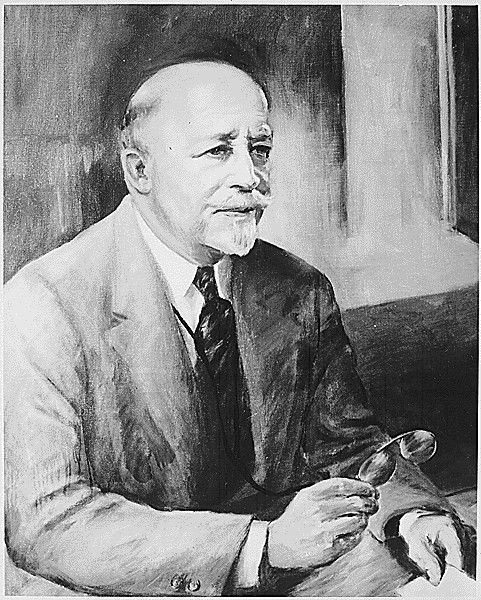"Muckraking" for a Purpose
Making Connections
All documents and text associated with this activity are printed below, followed by a worksheet for student responses.Introduction
Nearing the turn of the century many Americans were convinced that industrialization and urbanization had created severe problems. The movement towards reforming these problems eventually became known as progressivism. In this activity you will examine primary sources from this era. These sources will examine the issues of living conditions, women's suffrage, working conditions, prohibition, and African-Americans' rights. As you examine the sources answer the questions at the conculsion of each document set. When you have completed the document analysis you will be ask to write about the effectiveness of this reform movement.Name:
Class:
Class:
Worksheet
"Muckraking" for a Purpose
Making Connections
Examine the documents and text included in this activity. Fill in any blanks in the sequence with your thoughts and write your conclusion response in the space provided.Letter from Upton Sinclair to President Theodore Roosevelt

What does this letter tell us about muckrakers' like Mr. Sinclair, attitudes towards the governments efforts to reform?
Women munition workers urge President to support suffrage bill. Six women war workers . . .

Photograph of Suffrage Parade

Suffragettes at Washington, District of Columbia bonfire at White House

Photograph of Flag Bearer for Women's Rights Standing Near White House

Letter from National Child Labor Committee Regarding Child Labor Reform

Photograph of the Asch Building after the Triangle Shirtwaist Factory Fire

Photograph of the Building Interior after the Triangle Shirtwaist Factory Fire

Photograph of a Broken Fire Escape after the Triangle Shirtwaist Factory Fire

Demonstration of Protest and Mourning for Triangle Shirtwaist Factory Fire of March 25, 1911

What is the relationship between the letter and the images from the triangle shirtwaist factory?
Liquor Prohibition Ordinance 1900, Ordert No. 3 , An Ordinance to prohibit the supply of Intoxicating Liquors to Natives

Letter from Mrs. Hillyer concerning her husband's drinking activities.

Photograph of Prohibition Agents Destroying a Bar

What motives and methods are evident in these sources for banning alcohol?
W.E.B. DuBois

After reading the exert from du bois' essay, what message is du Bois hoping to send to Afrcian Americans?
1
Activity Element
Letter from Upton Sinclair to President Theodore Roosevelt
Page 1

2
Activity Element
Women munition workers urge President to support suffrage bill. Six women war workers . . .
Page 2

3
Activity Element
Photograph of Suffrage Parade
Page 2

4
Activity Element
Suffragettes at Washington, District of Columbia bonfire at White House
Page 1

5
Activity Element
Photograph of Flag Bearer for Women's Rights Standing Near White House
Page 1

6
Activity Element
Letter from National Child Labor Committee Regarding Child Labor Reform
Page 1

7
Activity Element
Photograph of the Asch Building after the Triangle Shirtwaist Factory Fire
Page 1

8
Activity Element
Photograph of the Building Interior after the Triangle Shirtwaist Factory Fire
Page 1

9
Activity Element
Photograph of a Broken Fire Escape after the Triangle Shirtwaist Factory Fire
Page 1

10
Activity Element
Demonstration of Protest and Mourning for Triangle Shirtwaist Factory Fire of March 25, 1911
Page 1

11
Activity Element
Liquor Prohibition Ordinance 1900, Ordert No. 3 , An Ordinance to prohibit the supply of Intoxicating Liquors to Natives
Page 1

12
Activity Element
Letter from Mrs. Hillyer concerning her husband's drinking activities.
Page 1

13
Activity Element
Photograph of Prohibition Agents Destroying a Bar
Page 1

14
Activity Element
W.E.B. DuBois
Page 1

Conclusion
"Muckraking" for a Purpose
Making Connections
After analyzing these primary sources, what evidence do they provide for the need to reform? Which of these reforms do you feel was most important? Support your response using both the primary sources from this activiy and information from your text. Include a total of four primary sources with one being a document.Your Response
Document
Letter from Upton Sinclair to President Theodore Roosevelt
3/10/1906
In this letter to President Roosevelt, author Upton Sinclair expresses his support for the presence of federal inspectors in the meat-packing houses. He advised that inspectors should come disguised as workingmen to discover the true conditions, as Sinclair did when he researched his book The Jungle.
The Jungle riled up the United States and its President, Teddy Roosevelt, by revealing the unsanitary conditions under which food was made. On June 30, 1906, President Roosevelt signed into law the Pure Food and Drug Act, effectively creating the Food and Drug Administration.
Roosevelt had read an advanced copy of The Jungle. But almost before he finished reading it—barely a week after its first publication—Sinclair was peppering the President with letters and recommendations on how to regulate the industry. Roosevelt was sympathetic to Sinclair’s desire to regulate the industry but despised the man’s zealotry. "Tell Sinclair to go home and let me run the country for a while," Roosevelt said. Still, the two shared a lunch at the White House and an extensive correspondence—possibly sharing more letters than any President with an author who wasn’t writing a biography. Sinclair’s passionate descriptions of the meatpacking industry, and Roosevelt’s pursuit of reform in the industry, led to the nation’s first consumer protection laws.
The Jungle riled up the United States and its President, Teddy Roosevelt, by revealing the unsanitary conditions under which food was made. On June 30, 1906, President Roosevelt signed into law the Pure Food and Drug Act, effectively creating the Food and Drug Administration.
Roosevelt had read an advanced copy of The Jungle. But almost before he finished reading it—barely a week after its first publication—Sinclair was peppering the President with letters and recommendations on how to regulate the industry. Roosevelt was sympathetic to Sinclair’s desire to regulate the industry but despised the man’s zealotry. "Tell Sinclair to go home and let me run the country for a while," Roosevelt said. Still, the two shared a lunch at the White House and an extensive correspondence—possibly sharing more letters than any President with an author who wasn’t writing a biography. Sinclair’s passionate descriptions of the meatpacking industry, and Roosevelt’s pursuit of reform in the industry, led to the nation’s first consumer protection laws.
This primary source comes from the Records of the Office of the Secretary of Agriculture.
National Archives Identifier: 301981
Full Citation: Letter from Upton Sinclair to President Theodore Roosevelt; 3/10/1906; Letters Received, 1893 - 1906; Records of the Office of the Secretary of Agriculture, ; National Archives at College Park, College Park, MD. [Online Version, https://www.docsteach.org/documents/document/sinclair-roosevelt, May 14, 2024]Letter from Upton Sinclair to President Theodore Roosevelt
Page 1
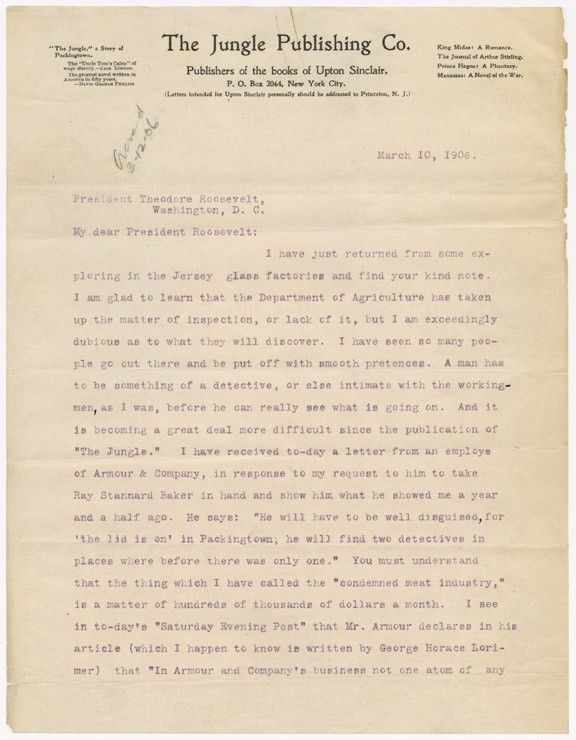
Letter from Upton Sinclair to President Theodore Roosevelt
Page 2
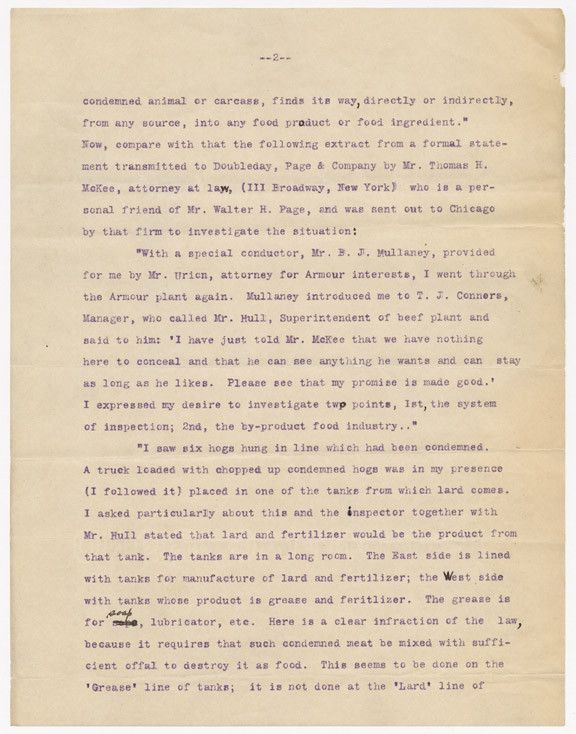
Letter from Upton Sinclair to President Theodore Roosevelt
Page 3
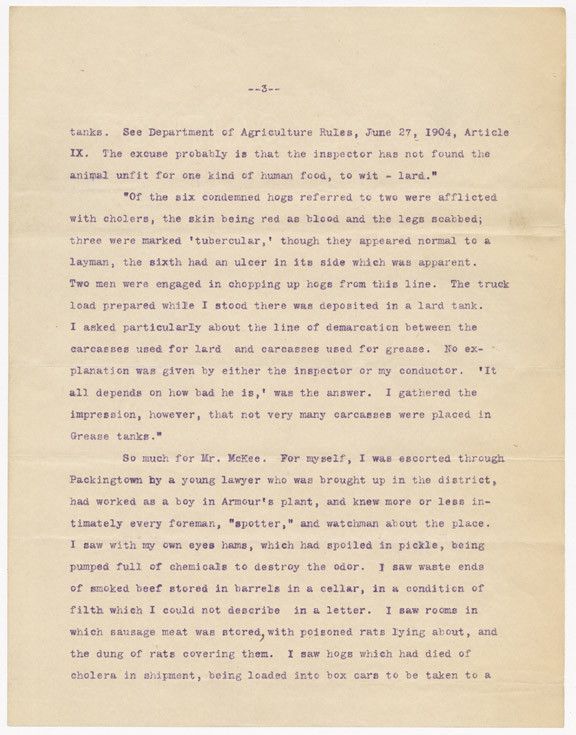
Letter from Upton Sinclair to President Theodore Roosevelt
Page 4
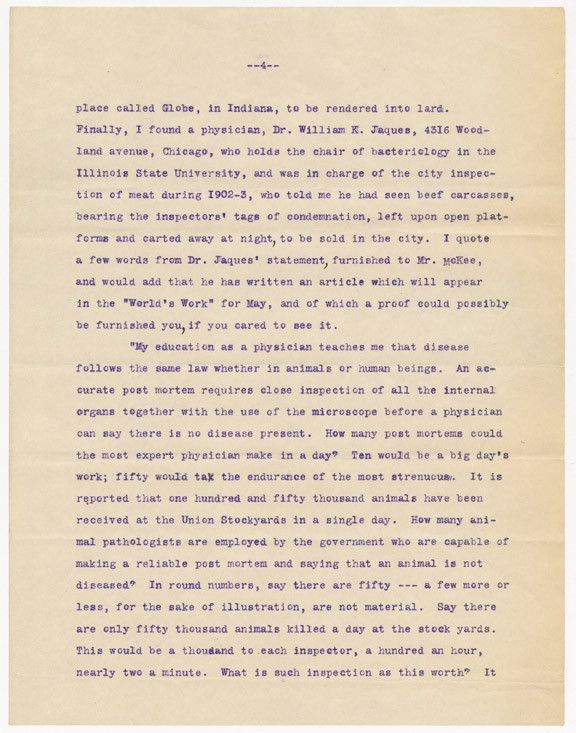
Letter from Upton Sinclair to President Theodore Roosevelt
Page 5
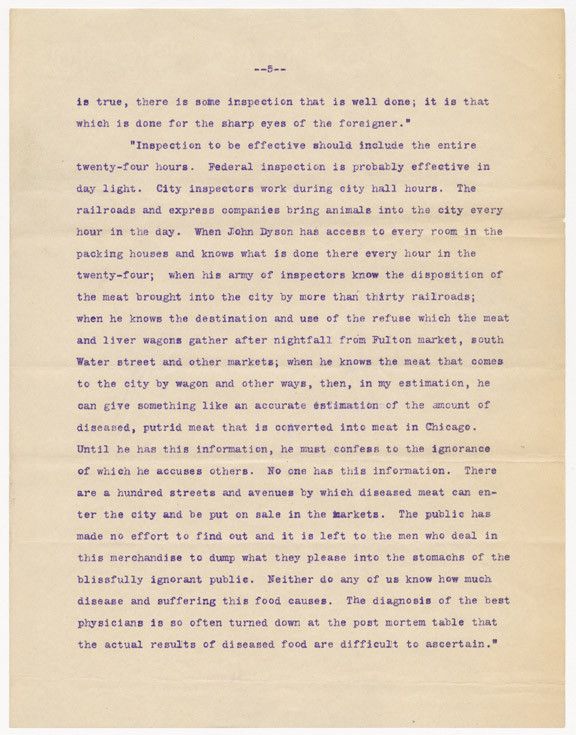
Letter from Upton Sinclair to President Theodore Roosevelt
Page 6
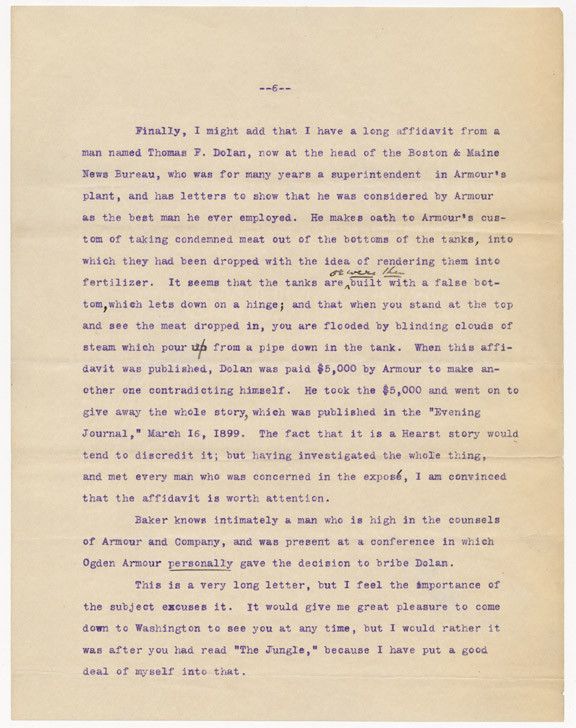
Letter from Upton Sinclair to President Theodore Roosevelt
Page 7
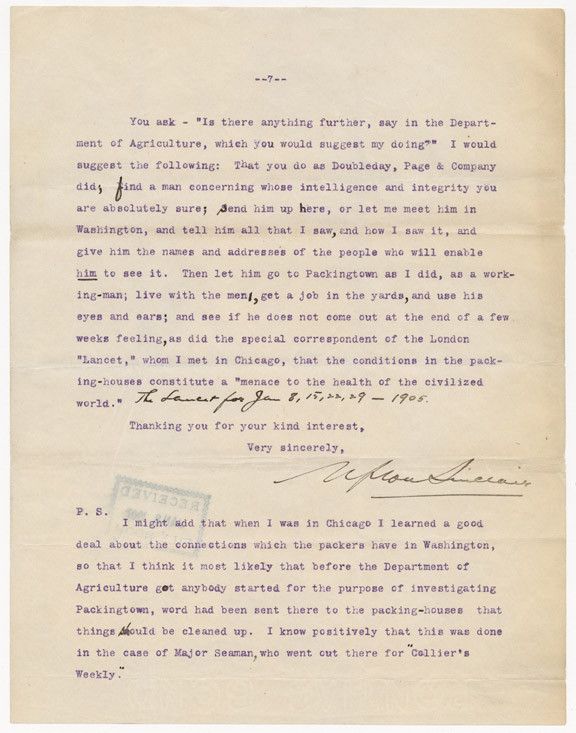
Document
Women munition workers urge President to support suffrage bill.
5/24/1918
These women at the Bethlehem Steel Company plant in New Castle, Delaware, met with President Woodrow Wilson to urge him to support the bill for women's suffrage, that would become the 19th amendment.
The original caption for this photograph reads: Women munition workers urge President to support suffrage bill. Six women war workers, representing thousands of others, were delegated to see President Wilson and urge him to support the motion for an immediate passage of the federal suffrage amendment. These women were employed at Bethlehem Steel Company's plant at Newcastle, Pennsylvania [sic]. They supplemented their argument with the statement that the women are serving the government in war industries and feel the urgent need of federal enfranchisement. From left to right: Miss Mary Gonzon, Mrs. Florence B. Hilles, Miss Lulu Patterson, Mrs. Marie McKensie, Miss Aida Walling and Mrs. Catherine Boyle.
The original caption for this photograph reads: Women munition workers urge President to support suffrage bill. Six women war workers, representing thousands of others, were delegated to see President Wilson and urge him to support the motion for an immediate passage of the federal suffrage amendment. These women were employed at Bethlehem Steel Company's plant at Newcastle, Pennsylvania [sic]. They supplemented their argument with the statement that the women are serving the government in war industries and feel the urgent need of federal enfranchisement. From left to right: Miss Mary Gonzon, Mrs. Florence B. Hilles, Miss Lulu Patterson, Mrs. Marie McKensie, Miss Aida Walling and Mrs. Catherine Boyle.
This primary source comes from the Records of the War Department General and Special Staffs.
National Archives Identifier: 533770
Full Citation: Photograph 165-WW-(600A)6; Women munition workers urge President to support suffrage bill.; 5/24/1918; American Unofficial Collection of World War I Photographs, 1917 - 1918; Records of the War Department General and Special Staffs, ; National Archives at College Park, College Park, MD. [Online Version, https://www.docsteach.org/documents/document/munition-workers-suffrage, May 14, 2024]Women munition workers urge President to support suffrage bill.
Page 2

Document
Photograph of Suffrage Parade
1913
In 1906, Elizabeth Cady Stanton’s daughter, Harriot Stanton Blatch, created the Equality League for Self-Supporting Women for professional and industrial working women, later called the Women’s Political Union. Taking the lead from labor unions, the Women’s Political Union organized the first suffrage parade in New York City in 1910.
This photograph of the fourth annual suffrage parade in New York City in 1913 shows some of the march’s 10,000 participants. In the early 20th century, suffragists marched, petitioned, lobbied, and were even arrested in their pursuit of voting rights for women. In 1920, the 19th Amendment to the U.S. Constitution granted women the right to vote.
This photograph of the fourth annual suffrage parade in New York City in 1913 shows some of the march’s 10,000 participants. In the early 20th century, suffragists marched, petitioned, lobbied, and were even arrested in their pursuit of voting rights for women. In 1920, the 19th Amendment to the U.S. Constitution granted women the right to vote.
This primary source comes from the Records of the Office of War Information.
National Archives Identifier: 593561
Full Citation: Photograph 208-PR-14M-3; Photograph of Suffrage Parade; 1913; Photographs Used in Publications, 1943 - 1945; Records of the Office of War Information, ; National Archives at College Park, College Park, MD. [Online Version, https://www.docsteach.org/documents/document/suffrage-parade, May 14, 2024]Photograph of Suffrage Parade
Page 2
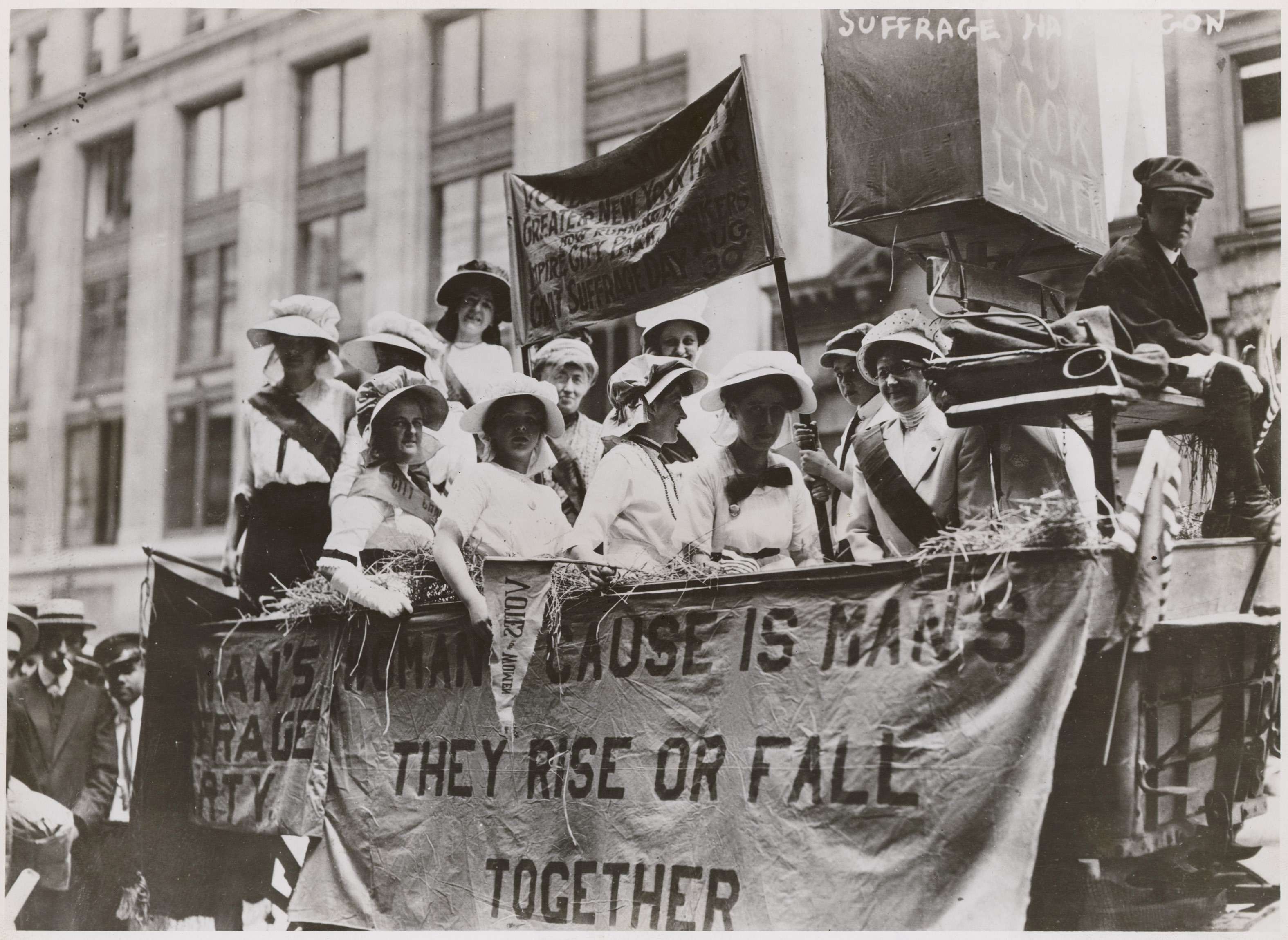
Document
Suffragettes at Washington, District of Columbia bonfire at White House
1917 - 1918
The original caption for this photograph reads: Suffragettes at Washington, District of Columbia bonfire at White House. It was taken by photographers Harris & Ewing.
Frustrated with President Woodrow Wilson’s inaction on woman suffrage, the National Woman’s Party picketed the White House, the first political activists to do so.
They began peacefully protesting six days a week in January 1917, but encountered hostile crowds after the United States entered World War I in April. Dozens of women were arrested, many of whom were jailed and force-fed. The resulting publicity and public outcry over their treatment is often credited with compelling President Woodrow Wilson to support woman suffrage.
The protesters demonstrated for nearly 30 months until Congress passed a joint resolution proposing a 19th amendment on June 4, 1919.
Frustrated with President Woodrow Wilson’s inaction on woman suffrage, the National Woman’s Party picketed the White House, the first political activists to do so.
They began peacefully protesting six days a week in January 1917, but encountered hostile crowds after the United States entered World War I in April. Dozens of women were arrested, many of whom were jailed and force-fed. The resulting publicity and public outcry over their treatment is often credited with compelling President Woodrow Wilson to support woman suffrage.
The protesters demonstrated for nearly 30 months until Congress passed a joint resolution proposing a 19th amendment on June 4, 1919.
This primary source comes from the Records of the War Department General and Special Staffs.
National Archives Identifier: 533785
Full Citation: Photograph 165-WW-(600A)21; Suffragettes at Washington, District of Columbia bonfire at White House; 1917 - 1918; American Unofficial Collection of World War I Photographs, 1917 - 1918; Records of the War Department General and Special Staffs, ; National Archives at College Park, College Park, MD. [Online Version, https://www.docsteach.org/documents/document/suffragettes-bonfire-white-house, May 14, 2024]Suffragettes at Washington, District of Columbia bonfire at White House
Page 1
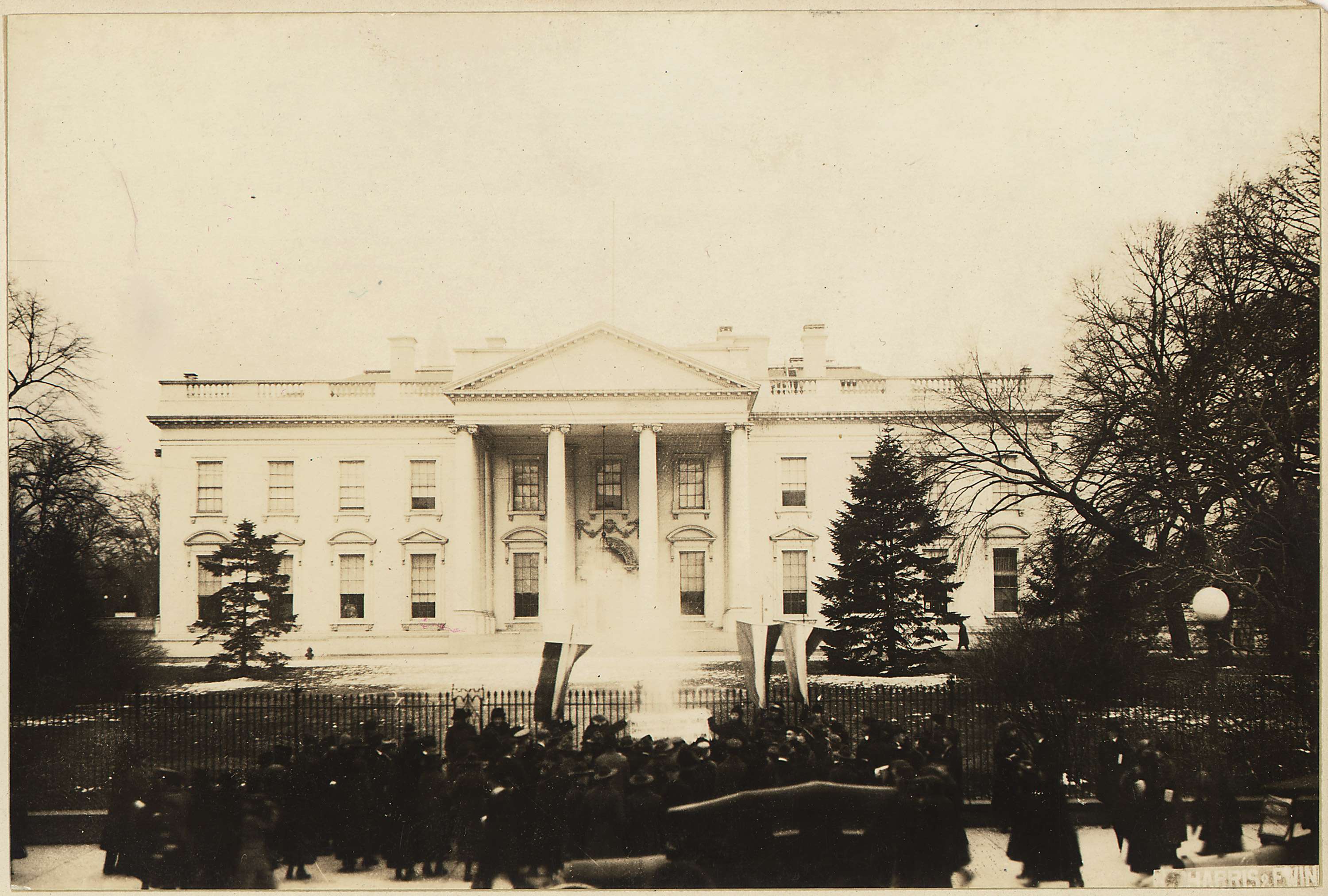
Document
Photograph of Flag Bearer for Women's Rights Standing Near White House
1/30/1917
Frustrated with President Woodrow Wilson’s inaction on woman suffrage, the National Women’s Party (NWP) began picketing in front of the White House to press for voting rights for women; they were the first political activists to do so.
This photograph of "Silent Sentinel" Alison Turnbull Hopkins outside the White House poses the central question of the matter. Her banner reads: "Mr. President How Long Must Women Wait for Liberty."
The NWP began peacefully protesting six days a week in January 1917, but encountered hostile crowds after the United States entered World War I in April. Dozens of women were arrested, many of whom were jailed and force-fed. The resulting publicity and public outcry over their treatment is often credited with compelling President Woodrow Wilson to support woman suffrage.
The protesters demonstrated for nearly 30 months until Congress passed a joint resolution proposing a 19th amendment on June 4, 1919.
This photograph of "Silent Sentinel" Alison Turnbull Hopkins outside the White House poses the central question of the matter. Her banner reads: "Mr. President How Long Must Women Wait for Liberty."
The NWP began peacefully protesting six days a week in January 1917, but encountered hostile crowds after the United States entered World War I in April. Dozens of women were arrested, many of whom were jailed and force-fed. The resulting publicity and public outcry over their treatment is often credited with compelling President Woodrow Wilson to support woman suffrage.
The protesters demonstrated for nearly 30 months until Congress passed a joint resolution proposing a 19th amendment on June 4, 1919.
This primary source comes from the Records of the U.S. Information Agency.
National Archives Identifier: 594266
Full Citation: Photograph 306-N-70-2641; Photograph of Flag Bearer for Women's Rights Standing Near White House; 1/30/1917; Photographs of U.S. and Foreign Personalities, World Events, and American Economic, Social, and Cultural Life, ca. 1953 - ca. 1994; Records of the U.S. Information Agency, ; National Archives at College Park, College Park, MD. [Online Version, https://www.docsteach.org/documents/document/flag-bearer-womens-rights, May 14, 2024]Photograph of Flag Bearer for Women's Rights Standing Near White House
Page 1
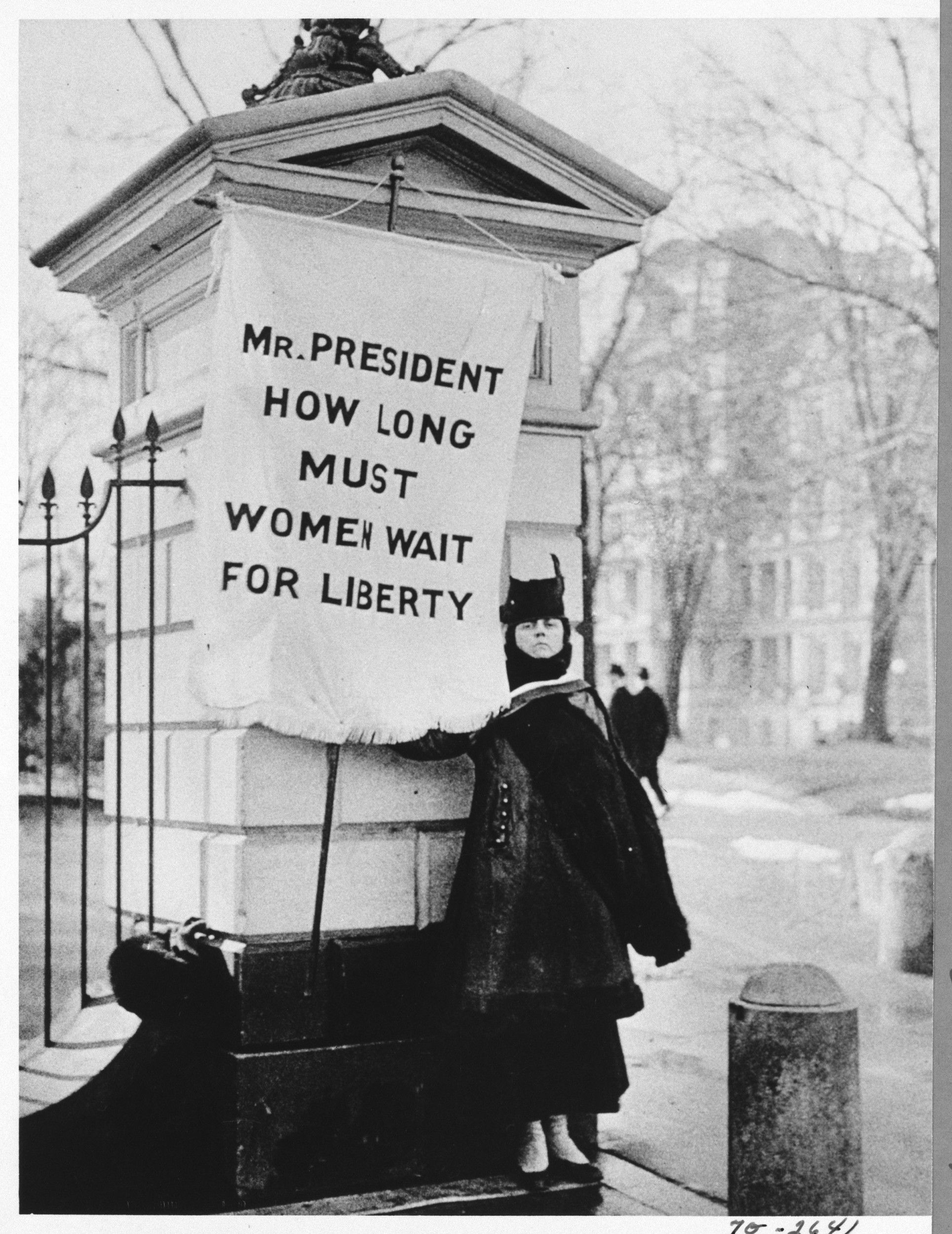
Document
Letter from National Child Labor Committee Regarding Child Labor Reform
8/21/1914
This primary source comes from the Records of the U.S. House of Representatives.
National Archives Identifier: 5685990
Full Citation: Letter from National Child Labor Committee Regarding Child Labor Reform; 8/21/1914; (HR63A-H16.2); Committee Papers, 1883 - 1946; Records of the U.S. House of Representatives, ; National Archives Building, Washington, DC. [Online Version, https://www.docsteach.org/documents/document/national-child-labor-committee-letter, May 14, 2024]Letter from National Child Labor Committee Regarding Child Labor Reform
Page 1
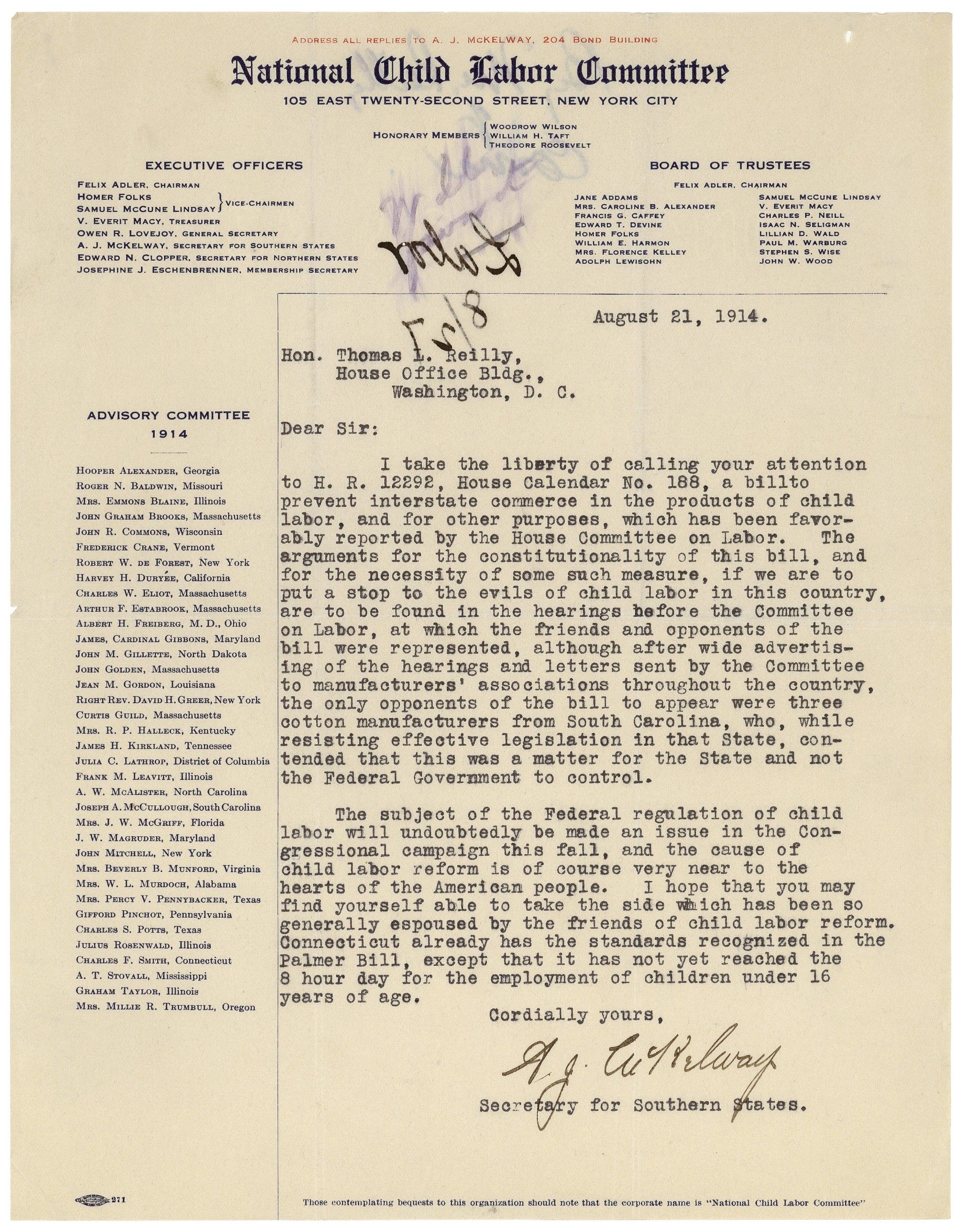
Document
Photograph of the Asch Building after the Triangle Shirtwaist Factory Fire
3/25/1911
On March 25, 1911, a fire at the Triangle Shirtwaist Factory, in the Asch Building on New York City‘s East Side, killed 146 young immigrant workers. The building, which was ten stories high, was overcrowded and filled with flammable material.
The fire started in a wastebasket on the eighth floor, and the flames jumped up onto the paper patterns that were hanging from the ceiling. Locked doors kept the workers from escaping; there was not enough water to put out the flames, and firemen’s ladders were too short to reach the upper stories. Many of the young women and men working there leapt out the windows and fell to their deaths onto the sidewalk outside. Others were crushed in the elevator shaft or when the fire escape collapsed.
Protests after the fire led New York State to revamp laws governing working conditions, increase the number of fire inspectors, and write new fire safety codes.
The fire started in a wastebasket on the eighth floor, and the flames jumped up onto the paper patterns that were hanging from the ceiling. Locked doors kept the workers from escaping; there was not enough water to put out the flames, and firemen’s ladders were too short to reach the upper stories. Many of the young women and men working there leapt out the windows and fell to their deaths onto the sidewalk outside. Others were crushed in the elevator shaft or when the fire escape collapsed.
Protests after the fire led New York State to revamp laws governing working conditions, increase the number of fire inspectors, and write new fire safety codes.
This primary source comes from the Collection FDR-Photos: Franklin D. Roosevelt Library Photographs.
National Archives Identifier: 6040078
Full Citation: Photograph NPx 77-121 (16); Photograph of the Asch Building after the Triangle Shirtwaist Factory Fire; 3/25/1911; Photographs from the Depression and World War II, 1870 - 2004; Collection FDR-Photos: Franklin D. Roosevelt Library Photographs, ; Franklin D. Roosevelt Library, Hyde Park, NY. [Online Version, https://www.docsteach.org/documents/document/asch-building-after-triangle-shirtwaist-factory-fire, May 14, 2024]Photograph of the Asch Building after the Triangle Shirtwaist Factory Fire
Page 1
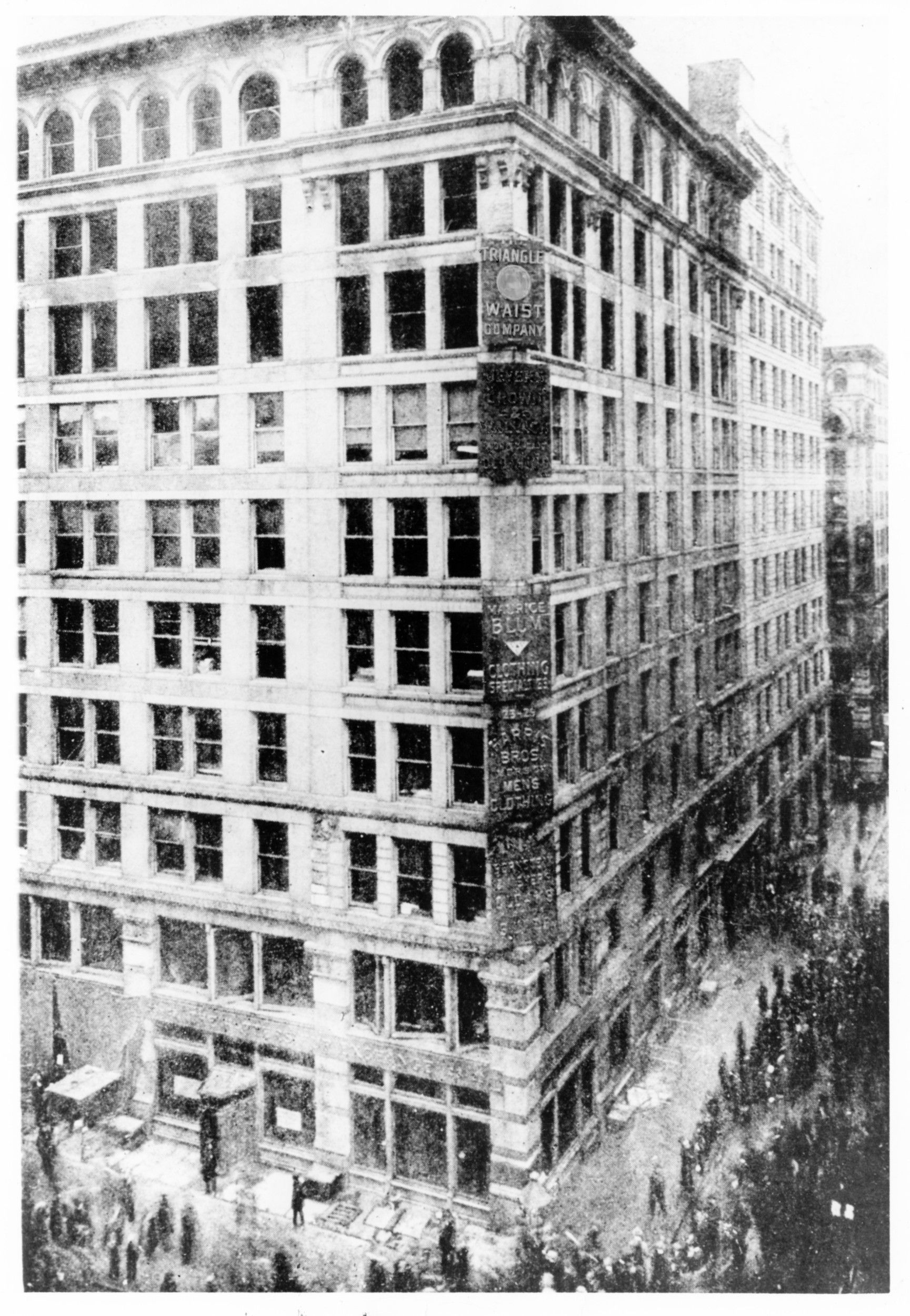
Document
Photograph of the Building Interior after the Triangle Shirtwaist Factory Fire
3/25/1911
On March 25, 1911, a fire at the Triangle Shirtwaist Factory on New York City‘s East Side killed 146 young immigrant workers. The building, which was ten stories high, was overcrowded and filled with flammable material.
The fire started in a wastebasket on the eighth floor, and the flames jumped up onto the paper patterns that were hanging from the ceiling. Locked doors kept the workers from escaping; there was not enough water to put out the flames, and firemen’s ladders were too short to reach the upper stories. Many of the young women and men working there leapt out the windows and fell to their deaths onto the sidewalk outside. Others were crushed in the elevator shaft or when the fire escape collapsed.
Protests after the fire led New York State to revamp laws governing working conditions, increase the number of fire inspectors, and write new fire safety codes.
The fire started in a wastebasket on the eighth floor, and the flames jumped up onto the paper patterns that were hanging from the ceiling. Locked doors kept the workers from escaping; there was not enough water to put out the flames, and firemen’s ladders were too short to reach the upper stories. Many of the young women and men working there leapt out the windows and fell to their deaths onto the sidewalk outside. Others were crushed in the elevator shaft or when the fire escape collapsed.
Protests after the fire led New York State to revamp laws governing working conditions, increase the number of fire inspectors, and write new fire safety codes.
This primary source comes from the Collection FDR-Photos: Franklin D. Roosevelt Library Photographs.
National Archives Identifier: 6040082
Full Citation: Photograph of the Building Interior after the Triangle Shirtwaist Factory Fire; 3/25/1911; Photographs from the Depression and World War II, 1870 - 2004; Collection FDR-Photos: Franklin D. Roosevelt Library Photographs, ; Franklin D. Roosevelt Library, Hyde Park, NY. [Online Version, https://www.docsteach.org/documents/document/building-interior-triangle-shirtwaist-factory-fire, May 14, 2024]Photograph of the Building Interior after the Triangle Shirtwaist Factory Fire
Page 1
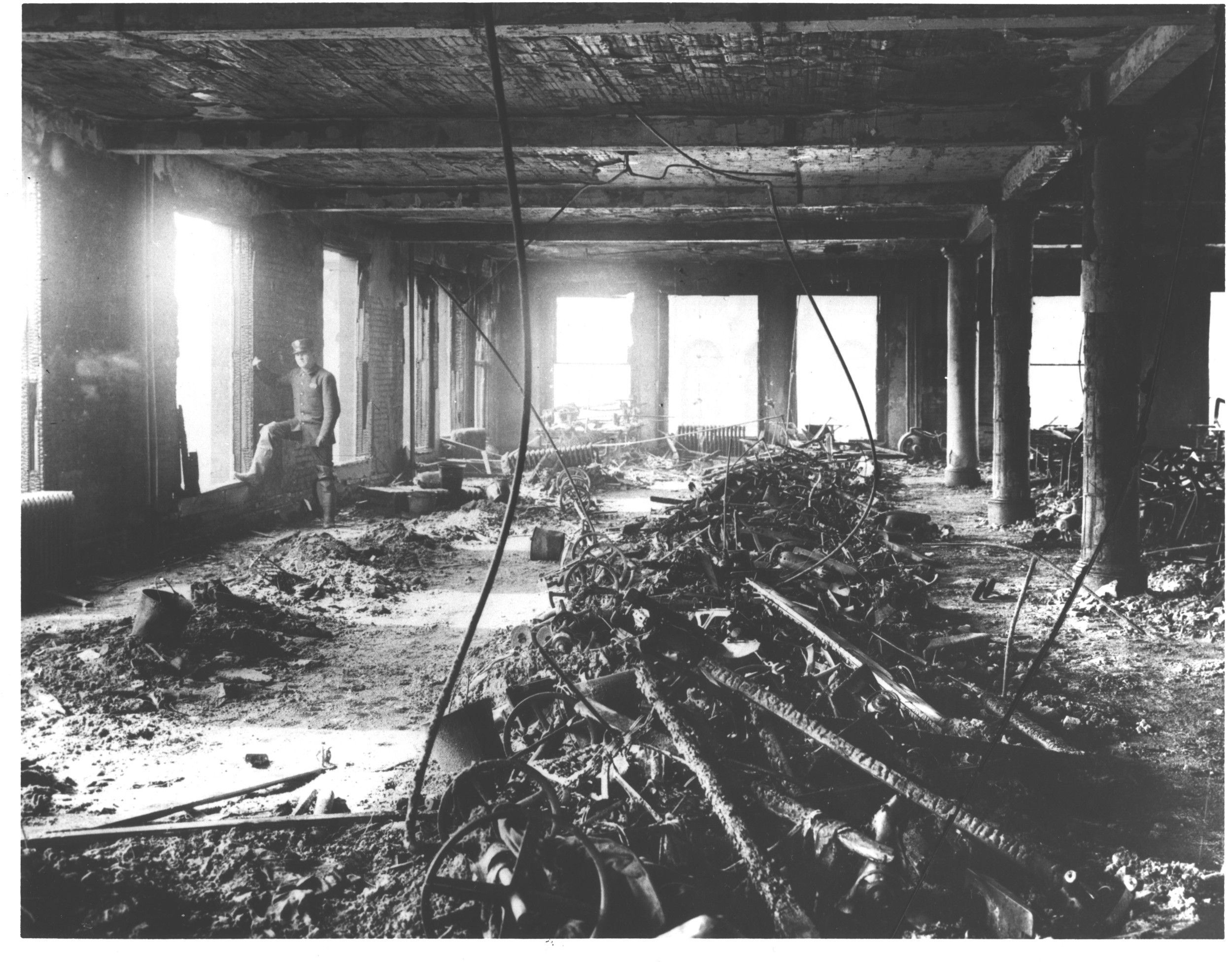
Document
Photograph of a Broken Fire Escape after the Triangle Shirtwaist Factory Fire
3/25/1911
On March 25, 1911, a fire at the Triangle Shirtwaist Factory on New York City‘s East Side killed 146 young immigrant workers. The building, which was ten stories high, was overcrowded and filled with flammable material.
The fire started in a wastebasket on the eighth floor, and the flames jumped up onto the paper patterns that were hanging from the ceiling. Locked doors kept the workers from escaping; there was not enough water to put out the flames, and firemen’s ladders were too short to reach the upper stories. Many of the young women and men working there leapt out the windows and fell to their deaths onto the sidewalk outside. Others were crushed in the elevator shaft or when the fire escape collapsed.
Protests after the fire led New York State to revamp laws governing working conditions, increase the number of fire inspectors, and write new fire safety codes.
The fire started in a wastebasket on the eighth floor, and the flames jumped up onto the paper patterns that were hanging from the ceiling. Locked doors kept the workers from escaping; there was not enough water to put out the flames, and firemen’s ladders were too short to reach the upper stories. Many of the young women and men working there leapt out the windows and fell to their deaths onto the sidewalk outside. Others were crushed in the elevator shaft or when the fire escape collapsed.
Protests after the fire led New York State to revamp laws governing working conditions, increase the number of fire inspectors, and write new fire safety codes.
This primary source comes from the Collection FDR-Photos: Franklin D. Roosevelt Library Photographs.
National Archives Identifier: 6040085
Full Citation: Photograph NPx 77-121 (20); Photograph of a Broken Fire Escape after the Triangle Shirtwaist Factory Fire; 3/25/1911; Photographs from the Depression and World War II, 1870 - 2004; Collection FDR-Photos: Franklin D. Roosevelt Library Photographs, ; Franklin D. Roosevelt Library, Hyde Park, NY. [Online Version, https://www.docsteach.org/documents/document/broken-fire-escape-triangle-shirtwaist-factory-fire, May 14, 2024]Photograph of a Broken Fire Escape after the Triangle Shirtwaist Factory Fire
Page 1
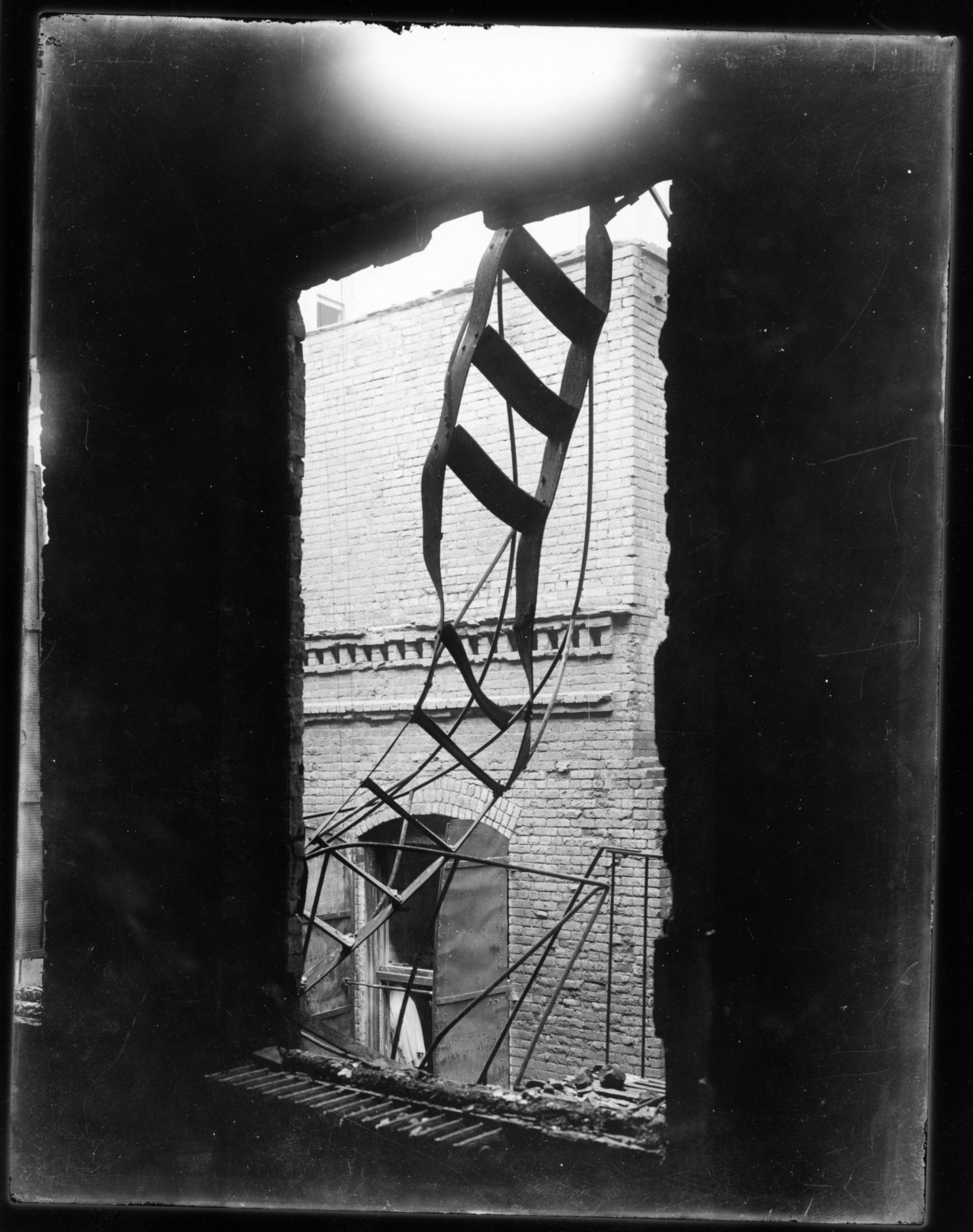
Document
Demonstration of Protest and Mourning for Triangle Shirtwaist Factory Fire of March 25, 1911
4/5/1911
On March 25, 1911, a fire at the Triangle Shirtwaist Factory on New York City‘s East Side killed 146 young immigrant workers. The building, which was ten stories high, was overcrowded and filled with flammable material.
The fire started in a wastebasket on the eighth floor, and the flames jumped up onto the paper patterns that were hanging from the ceiling. Locked doors kept the workers from escaping; there was not enough water to put out the flames, and firemen’s ladders were too short to reach the upper stories. Many of the young women and men working there leapt out the windows and fell to their deaths onto the sidewalk outside. Others were crushed in the elevator shaft or when the fire escape collapsed.
Protests after the fire led New York State to revamp laws governing working conditions, increase the number of fire inspectors, and write new fire safety codes.
The fire started in a wastebasket on the eighth floor, and the flames jumped up onto the paper patterns that were hanging from the ceiling. Locked doors kept the workers from escaping; there was not enough water to put out the flames, and firemen’s ladders were too short to reach the upper stories. Many of the young women and men working there leapt out the windows and fell to their deaths onto the sidewalk outside. Others were crushed in the elevator shaft or when the fire escape collapsed.
Protests after the fire led New York State to revamp laws governing working conditions, increase the number of fire inspectors, and write new fire safety codes.
This primary source comes from the General Records of the Department of Labor.
National Archives Identifier: 5730933
Full Citation: Photograph 174-G-22-50A; Demonstration of Protest and Mourning for Triangle Shirtwaist Factory Fire of March 25, 1911; 4/5/1911; Photographic Prints of Occupations, Labor Activities, and Personalities, 1940 - 1970; General Records of the Department of Labor, ; National Archives at College Park, College Park, MD. [Online Version, https://www.docsteach.org/documents/document/triangle-shirtwaist-demonstration, May 14, 2024]Demonstration of Protest and Mourning for Triangle Shirtwaist Factory Fire of March 25, 1911
Page 1

Document
Liquor Prohibition Ordinance 1900, Ordert No. 3 , An Ordinance to prohibit the supply of Intoxicating Liquors to Natives
4/28/1900
This primary source comes from the Records of the Government of American Samoa.
National Archives Identifier: 297000
Full Citation: Liquor Prohibition Ordinance 1900, Ordert No. 3 , An Ordinance to prohibit the supply of Intoxicating Liquors to Natives; 4/28/1900; Records of the Government of American Samoa, . [Online Version, https://www.docsteach.org/documents/document/liquor-prohibition-ordinance-1900-ordert-no-3-an-ordinance-to-prohibit-the-supply-of-intoxicating-liquors-to-natives, May 14, 2024]Liquor Prohibition Ordinance 1900, Ordert No. 3 , An Ordinance to prohibit the supply of Intoxicating Liquors to Natives
Page 1
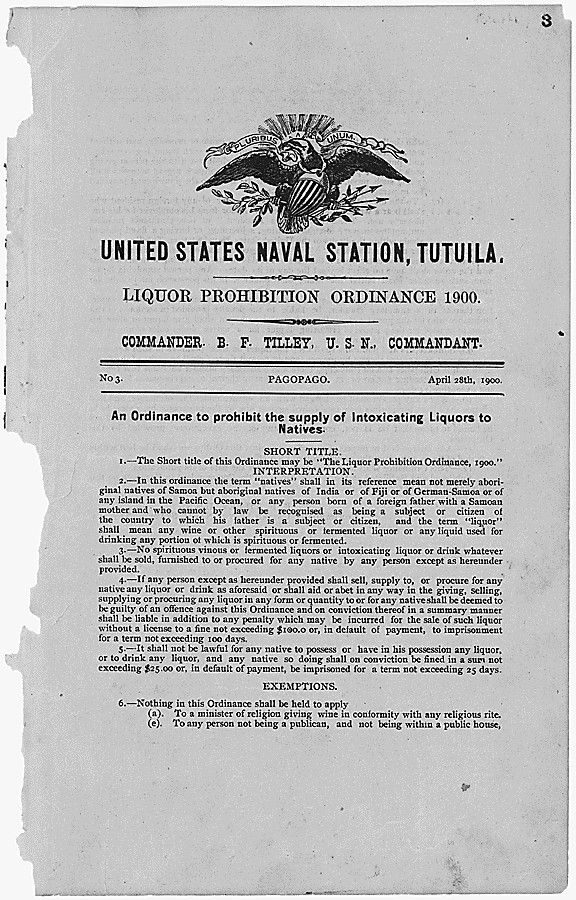
Liquor Prohibition Ordinance 1900, Ordert No. 3 , An Ordinance to prohibit the supply of Intoxicating Liquors to Natives
Page 2

Document
Letter from Mrs. Hillyer concerning her husband's drinking activities.
9/22/1931
This document pertains to the Seattle Conspiracy case, in which the Bureau of Prohibition investigated a conspiracy by members of the Seattle Police department and other government officials in the city to obtain protection money from those violating the National Prohibition Act. Members also sold confiscated liquor for profit. Included in the conspiracy was Frank Olmstead, a captain on the police force. His conviction was appealed to the Supreme Court on the grounds that the wire taps used to convict him were unconstitutional. In a dissenting opinion, Justice Brandeis agreed stating that officials should be required to get a search warrant before placing a wiretap on a telephone line.
This primary source comes from the General Records of the Department of the Treasury.
National Archives Identifier: 298490
Full Citation: Letter from Mrs. Hillyer concerning her husband's drinking activities.; 9/22/1931; Seattle Conspiracy (Olmstead) Investigation; Investigative Case Files, 1924–1933; General Records of the Department of the Treasury, ; National Archives at Seattle, Seattle, WA. [Online Version, https://www.docsteach.org/documents/document/letter-from-mrs-hillyer-concerning-her-husbands-drinking-activities, May 14, 2024]Letter from Mrs. Hillyer concerning her husband's drinking activities.
Page 1
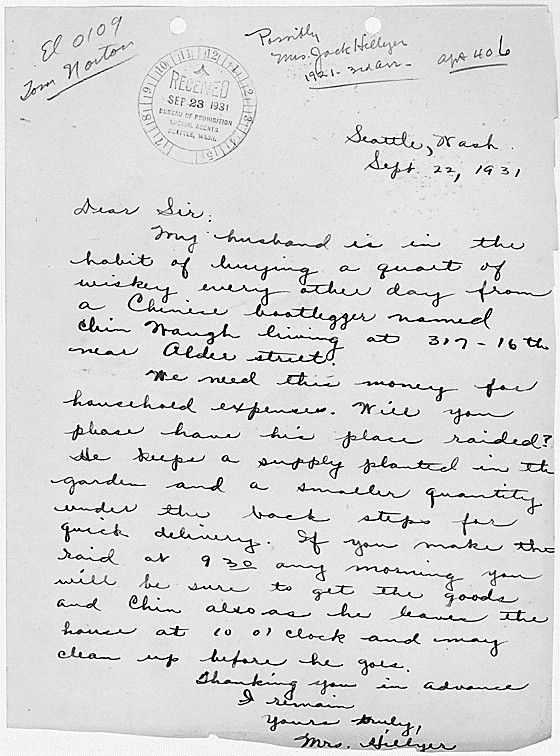
Document
Photograph of Prohibition Agents Destroying a Bar
ca. 1920-1933
Additional details from our exhibits and publications
After the ratification of the 18th Amendment to the Constitution, the manufacture, transportation, and sale of alcoholic beverages became illegal in the United States. Prohibition agents often used force to stop the sale of alcohol in clandestine bars or “speakeasies.” Prohibition lasted from 1920 until 1933, when the 18th Amendment was repealed.
This primary source comes from the Records of the U.S. Information Agency.
National Archives Identifier: 595674
Full Citation: Photograph of Prohibition Agents Destroying a Bar; ca. 1920-1933; Records of the U.S. Information Agency, . [Online Version, https://www.docsteach.org/documents/document/photograph-of-prohibition-agents-destroying-a-bar, May 14, 2024]Photograph of Prohibition Agents Destroying a Bar
Page 1
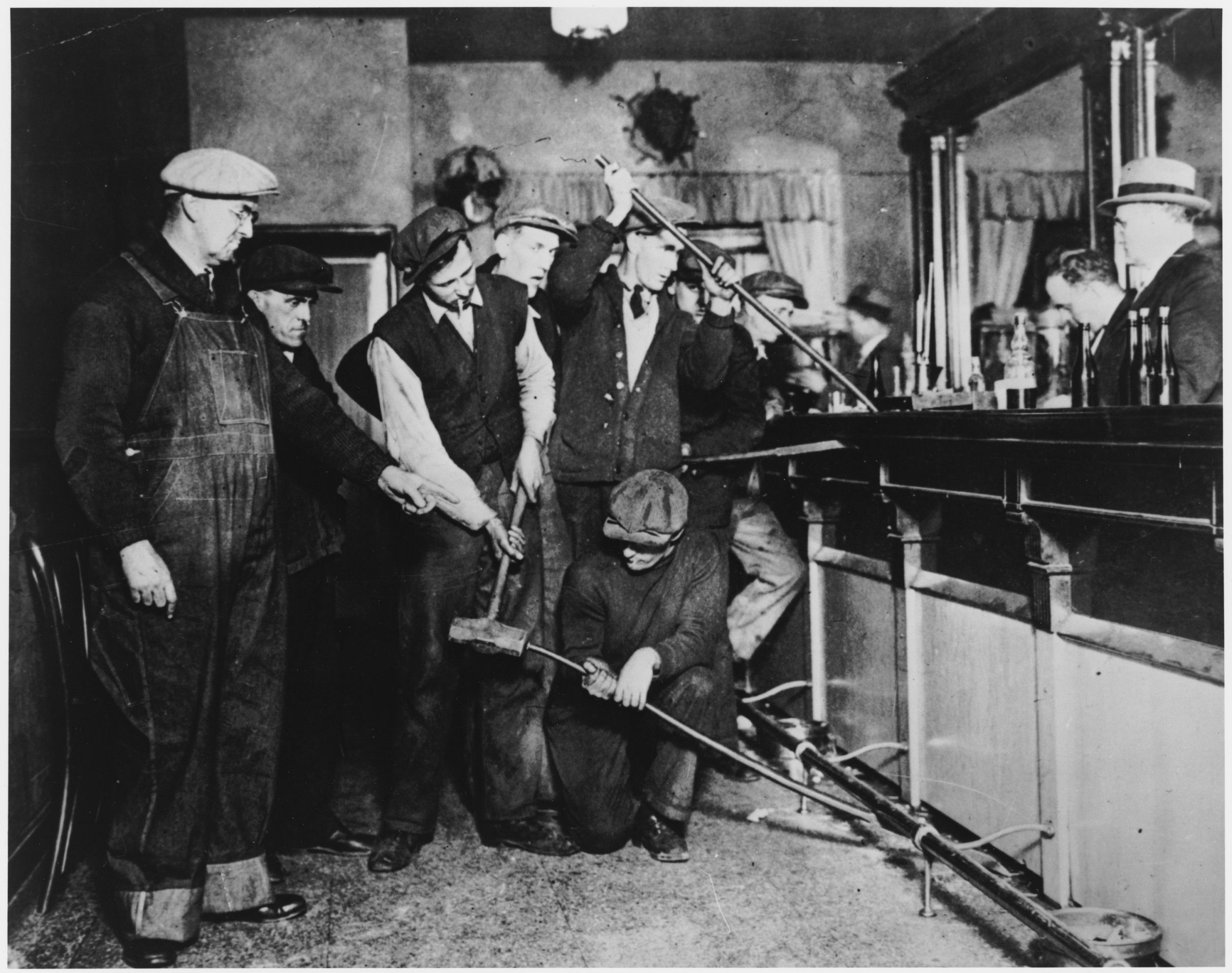
Document
W. E. B. DuBois
This image of the painting is part of the Harmon Foundation Collection. The Harmon Foundation, a nonprofit, private foundation active from 1922 to 1967, helped foster an awareness of African art. African artists would send their artworks to the United States for exhibit and sale. When the foundation ended its activities in 1967, it donated its entire collection of motion pictures, filmstrips, color slides, and black and white prints and negatives on a variety of subjects to the National Archives. Learn more on the National Archives website.
This primary source comes from the Collection H: Harmon Foundation Collection, 1922 - 1967.
National Archives Identifier: 559200
Full Citation: Artwork H-HNP-16; W. E. B. DuBois; "Portraits of Outstanding Americans of Negro Origin Painted by Two Women Artists", ca. 1943 - ca. 1963; Collection H: Harmon Foundation Collection, 1922 - 1967, ; National Archives at College Park, College Park, MD. [Online Version, https://www.docsteach.org/documents/document/web-dubois, May 14, 2024]W. E. B. DuBois
Page 1
